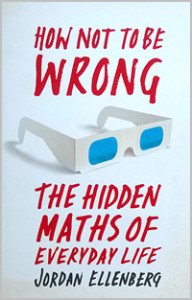How Not to be Wrong
The hidden maths of everyday life
by Jordan Ellenberg. Published by Penguin www.penguin.com
Make a million dollars on the lottery! In “How Not to be Wrong” professor of mathematics, Jordan Ellenberg tells us how. It worked for Voltaire in the 18th Century and it worked for MIT student James Harvey in the Massachusetts Lottery. I’ll get back to that.
For a book about mathematics, Ellenberg keeps actual maths pretty much out of the picture. There is a smattering of sums and occasional equations but solving them is not mandatory and you will not have to show your work. If you have an inclination towards puzzles though you may find yourself reaching for pencil and paper on occasion such as working out the chance of your neighbor being a terrorist (why let the NSA have all the fun?). Ellenbers’s ‘pay no attention to the maths behind the curtain’ style deals more with the ‘why’ of mathematics than the textbook nitty gritty of ‘how’ and explores the uses (where to armor your planes) and abuses (top 1% of earners are responsible for 131% of earnings) of numbers as well as the eccentric cast of mathematical innovators, their philosophies, fashions and occasionally vicious in-fighting.
If you’re a maths teacher, just go buy the book. Your students will love you for it, or, at least, hate your class less. For the rest of us; we may not use all the tricks and traps of mathematics but in the age of ‘big data’ we do need to know when they’re used against us.
As for those Lottery wins? They’re genuine, but alas, the method isn’t applicable to the Lottery on this side of the pond. At least I don’t think it is.
Hmmm… Where’s that pencil…?
